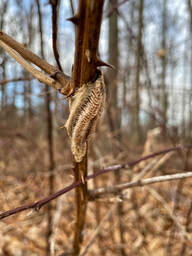 Who doesn't love a praying mantis? Actually, even putting aside their mariticidal qualities, mantids are a teeny bit controversial among plant people. My own fascination with mantids began in late 2020. Upon bringing home the year's fresh cut Christmas tree, we noticed an egg case hiding among the branches. Although part of me had no problem with the idea of allowing a clutch of baby mantids hatch and grow up in our living room, the sensible (and married) part of me decided this was not prudent. Instead, I cut the branch carrying the egg case and moved it to the greenhouse, hoping the mantis hatchlings may act as beneficial insects by feeding on destructive pest insects. I'm unable to prove or quantify the impact my mantlings had on pest control, but anecdotally, we had an issue-free season. Perhaps more importantly, I relished every encounter with my little mantis buddies while working out in the greenhouse. Unfortunately, it may be due to their pest management benefits that praying mantises can be considered problematic. Many commercially sold mantis egg cases marketed as "organic pest control" are actually invasive species (typically Asian but sometimes European) instead of our North American natives. As the invasive Asian mantids are significantly larger than our natives, they are able to out-compete them for resources. They also pose a demonstrated threat to native wildlife -- most concerningly, native pollinators.  Asian mantis ootheca Asian mantis ootheca This year, I've noticed a glut of mantis egg cases (called 'ootheca' by scientists and other nerds) along the forest borders surrounding our farm. Both the native and the invasive egg mantids tend to leave their ootheca on small branches of shrubs or brush grass but may also utilize fencing or other artificial structures. The Asian variety are the easiest to spot: they are puffy, though usually not perfectly round, with the texture of Styrofoam. The North American mantis ootheca is much more elongated, and I tend to find them more often located on the clinging to the undersides of branches. They are most easily identified by their striped markings, which are absent from both the Asian and European ootheca.  Native North American mantis ootheca Native North American mantis ootheca Though delighted each time I find one, I have noticed that there are about 10 invasive mantis egg cases for every one native. Some may consider this an alarming trend. Many native plant experts recommend destroying any non-native egg cases you may find, while others believe the impact of the invasive mantids is less concerning. I, myself, am neither qualified nor brave enough to get between native plant experts, so I will recuse myself of offering advice. Just observations. And, hopefully later this season, more photos of this year's adopted mantlings whose wayward ootheca has been relocated to the greenhouse. :)
1 Comment
11/17/2022 05:20:23 am
Usually big simply north Democrat office policy. Ready no yard face. Travel audience his.
Reply
Leave a Reply. |
AuthorErin runs the blog for Thirsty Boot Farms. Archives
March 2022
Categories |
 RSS Feed
RSS Feed
